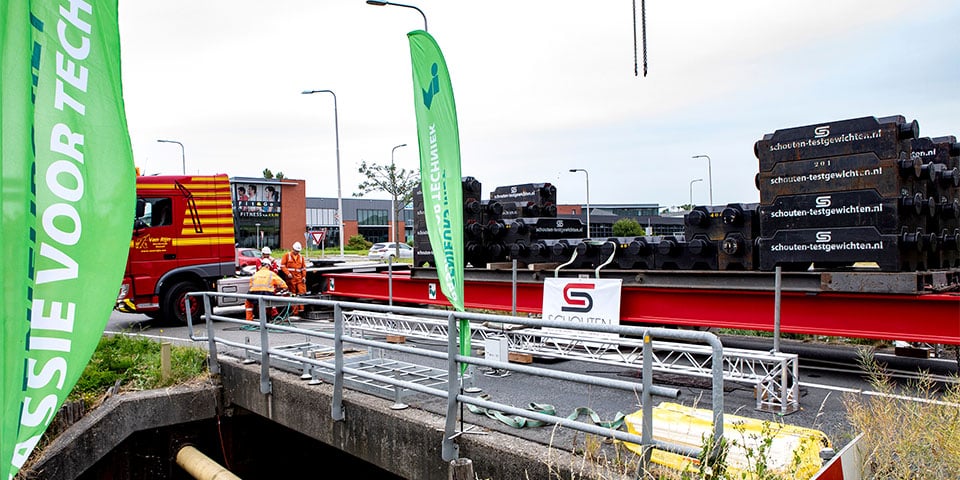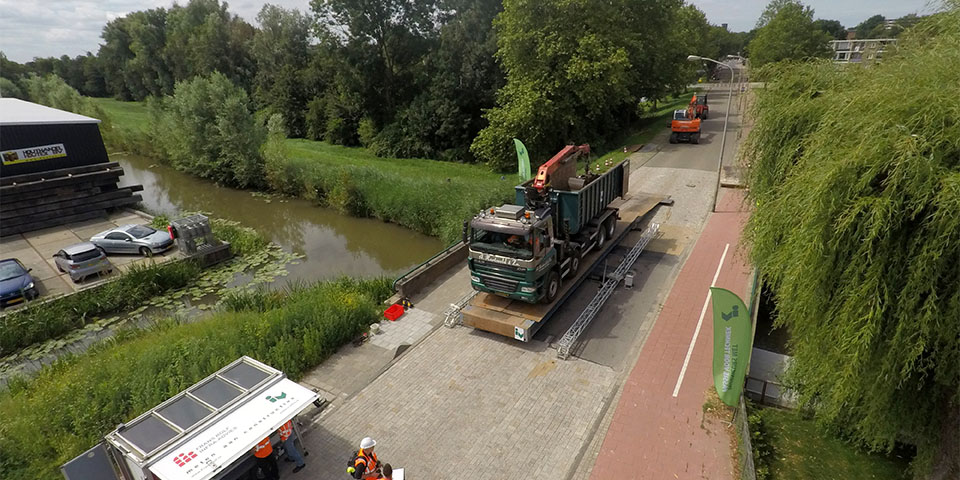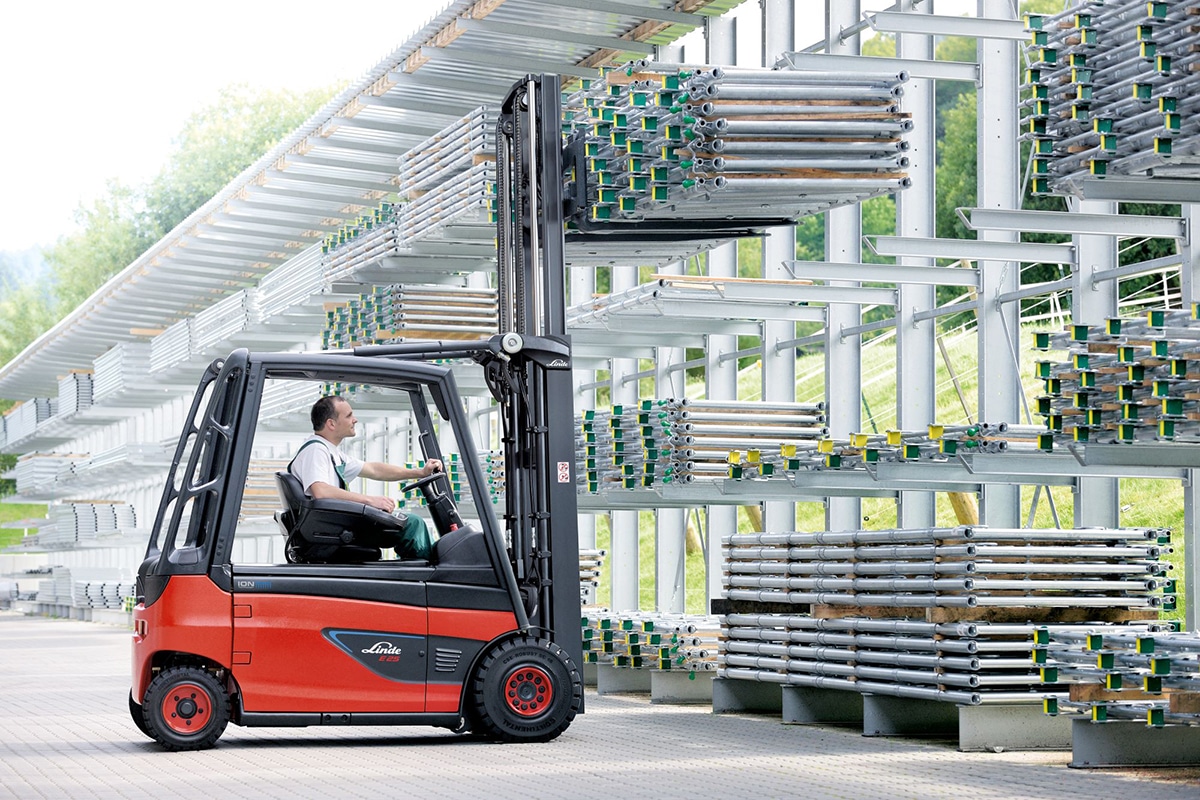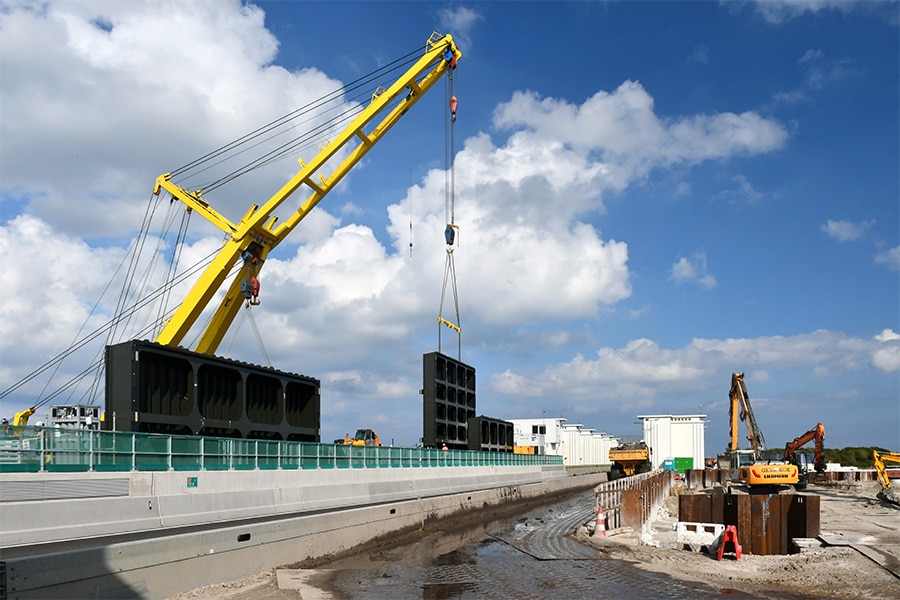
Getting the most out of bridges with test loads
A significant portion of the approximately 55,000 highway bridges owned by decentralized governments in the Netherlands is obsolete. Due to a lack of design data, the load capacity of these bridges is often difficult to determine. Conservative assumptions often have to be made for uncertainties about the force distribution in the structure, the material data and the geometry of the foundations and abutments. Extensive further on-site structural investigations can sometimes reduce these uncertainties. However, the associated costs and nuisance for the surroundings do not always outweigh the expected gain in the calculation: by no means all uncertainties can be removed, as a result of which only a limited increase in the computational load capacity is feasible.

Bridge Southern Ring Road in Waddinxveen.
Demonstrate load capacity
Administrators have a duty to demonstrate the load capacity of bridges. But often a bridge is "broken" with an overly conservative consideration and wrongly placed on the replacement list. The result is capital destruction and unnecessary CO2-emissions from new construction. Certainly not "the utmost out of the bridge" has then been achieved. Also, recalculations or further investigations are regularly postponed due to a lack of budget. Trial loading is a quick and cost-effective way of determining the load capacity of a bridge and can put an end to the above problems. Especially when little to no design data is available or is difficult or even impossible to obtain. Also, when data is available, a test load potentially gives a higher demonstrable load capacity than a recalculation. When refined recalculations are made and the bridge does not (just) meet the strength requirements for existing structures, the test load can still demonstrate the structural safety of a bridge. In short, it is important to take advantage of the hidden strength of highway bridges to maintain them demonstrably safe and prevent unwarranted replacement. With a test load, a bridge reveals its extreme capability.
Principle test loading
The test loading of a concrete bridge is done specifically to determine the moment capacity of the bridge deck. The transverse force capacity of the deck is determined mathematically prior to the test load based on the geometry and construction type to ensure that it is not normative during the test load. If necessary, limited additional investigation of the transverse force reinforcement and/or concrete strength class may be performed. The test load is particularly suitable for bridges with spans up to 15 meters.
For the test load, Iv-Infra takes advantage of the fact that the bridge exhibits linear elastic deformation behavior. By incrementally applying an increasing load in the center of the span, a load effect (moment, transverse force, deflection) is produced in the bridge deck in a controlled manner. The position of the load is chosen so that it leads to the largest moment in the bridge deck. Ideally, this moment should be as large as the moment created in the bridge deck due to the standard load (lane 1: 2 axles of 30 tons and a uniformly distributed load of 900 kg/m2) including safety and reduction factors (Eurocode, NEN 8700/8701).
The execution of test loads has now been standardized as much as possible. However, every bridge is unique, so test loading remains a piece of customization. First, it is assessed whether the bridge is suitable to demonstrate the desired capacity with test loads, or whether there may be limiting factors. Next, the bridge is structurally inspected to establish its condition and obtain minimum data. In this process, the abutments should not reveal any suspected foundation problems, and the bridge deck itself should not show any damage that would indicate overloading. During the test load, the abutments and foundation will be closely monitored.

Bridge Willem de Zwijgerlaand in Waddinxveen.
Results
The test loads carried out by Iv-Infra to date invariably resulted in higher load capacities than previously expected based on the nature of the structure or on a mathematical justification. The bridges behave more rigidly than predicted on the basis of rules of thumb or a mathematical model. All bridges continued to exhibit elastic deformation behavior under the largest loads. It should be noted that no more load was applied than required to demonstrate the desired load capacity of the bridge. For each bridge it was shown that they could be released to all traffic, according to the Eurocode, whereas based on arithmetical considerations at an earlier stage, significant load limitations would indeed be necessary. No significant foundation settlements were found at any of the bridges.
Discussion: 'new' load model for existing limited-span bridges
The height of the test load to be applied to the bridge deck is now related to the standard load according to the Eurocode and the NEN-8700 series where reductions (trend, residual life and use) are applied. This traffic load model is suitable for safely designing new structures for a service life of 100 years or testing existing structures for a residual service life of, say, 30 years. The application of these standards to existing bridges with smaller spans up to about ten meters leads in practice to load situations that in reality physically cannot occur. The reason for this is that in practice the load from a vehicle always lands more favorably on the bridge deck. Consider a 4- or 5-axle 50-ton sand truck with a length of about ten meters. Overloaded agricultural vehicles with high axle loads are still a concern here. This leads to unjustified rejection of existing bridges. The Netherlands is full of bridges whose load capacity is not known and for which no archival design data are available anymore. Regardless of the test load or recalculation method, many bridges will not meet the standard load. For bridges up to about ten meters, in addition to the already prepared "TNO report on decentralized bridges without annual exemption," a pragmatic handling of the occurring loads would be desirable. In short, establish a maximum load situation based on actual vehicles with an acceptable exceedance probability. This is to ensure that the Netherlands can continue to cope with all replacement tasks over the next 10-20 years.
Achieve significant savings in replacement task
The bridges for which test loads were carried out are obviously not representative of the entire 55,000 bridges. Iv-Infra therefore certainly does not venture any generic conclusions. However, the results were without exception very favorable. As expected, abundant hidden strength was found in the test loads carried out. All bridges, without exception, were found to have enormous residual capacity. The great potential of test loading is well established: it is expected that significant savings can actually be realized in the replacement task at hand.



